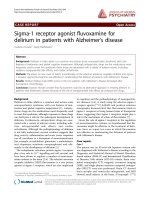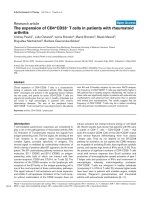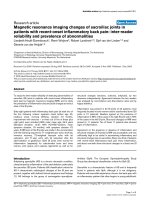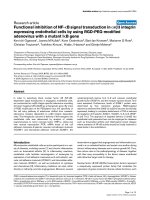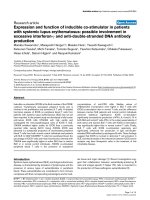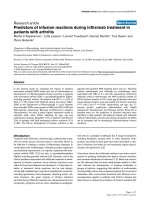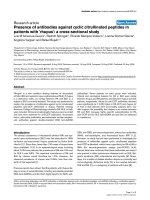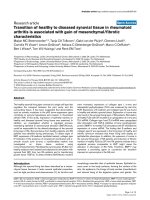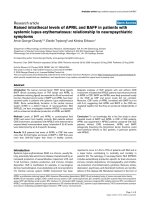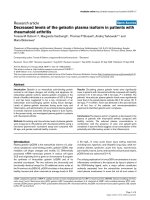Báo cáo y học: "Functional impairment related to painful physical symptoms in patients with generalized anxiety disorder with or without comorbid major depressive disorder: post hoc analysis of a crosssectional study" docx
Bạn đang xem bản rút gọn của tài liệu. Xem và tải ngay bản đầy đủ của tài liệu tại đây (482.32 KB, 10 trang )
RESEARC H ARTIC L E Open Access
Functional impairment related to painful physical
symptoms in patients with generalized anxiety
disorder with or without comorbid major
depressive disorder: post hoc analysis of a cross-
sectional study
Irene Romera
1*
, Ángel L Montejo
2
, Fernando Caballero
3
, Luis Caballero
4
, José Arbesú
5
, Pepa Polavieja
1
,
Durisala Desaiah
6
and Inmaculada Gilaberte
1
Abstract
Background: Generalized anxiety disorder (GAD) is the most frequent anxiety disorder in primary care patients. It is
known that painful physical symptoms (PPS) are associated with GAD, regardless the presence of comorbid major
depressive disorder (MDD). However the specific role of such symptoms in patients’ funct ional impairment is not
well understood. The objective of the present study is to assess functional impairment related to the presence of
PPS in patients with GAD.
Methods: This is a post hoc analysis of a cross-sectional study. Functioning, in the presence (overall pain score
>30; Visual Analog Scale) or absence of PPS, was assessed using the Sheehan Disability Scale (SDS) in three groups
of patients; 1) GAD and comorbid MDD (GAD+MDD+), 2) GAD without comorbid MDD (GAD+MDD-), 3) controls
(GAD-MDD-). ANCOVA models were used.
Results: Of those patients with GAD+MDD+ (n = 559), 436 (78.0%) had PPS, compared with GAD+MDD- (249 of 422,
59%) and controls (95 of 336, 28.3%). Functioning worsened in both GAD groups in presence of PPS (SDS least squares
mean total score: 16.1 vs. 9.8, p < 0.0001, GAD+MDD+; 14.3 vs. 8.2, p < 0.0001, GAD+MDD-). The presence of PPS was
significantly associated with less productivity.
Conclusions: Functional impairment related to the presence of PPS was relevant. Clinical implication s should be
considered.
Background
Generalized anxiety disorder (GAD), a mental disorde r
highly prevalent in primary care patients (8%-14%), is
generally associated with a significant impairment in
patients’ functioning [1,2]. Patients with GAD experience
functional impairments, such as diminished social rela-
tionships, poorer well-being, and less satisfaction with
life [3], that le ad to reduced quali ty of life in the areas o f
interaction with friends, self-realization, subjective well-
being [4,5], and work [6]. These patients are more likely
to have absences from work and short-term disabilities;
therefore, the indirect costs of the disease attributab le to
low productivity are increased [7]. The level of impair-
ment is substantial and is even comparable to that of
major depression [8]. As expected, the highest level of
functional impairment occurs when GAD is comorbid
with depression, which is a common feature in primary
care [1,8].
The pathological feature most uniquely associated with
GAD and that differentiates it from other anxiety disor-
ders is excessive, pervasive, and uncontrollable worrying
[9-12]. Such worrying in patients with GAD is frequently
* Correspondence:
1
Clinical Research Department, Lilly, SA, Avenida de la Industria, 30, 28108
Alcobendas, Spain
Full list of author information is available at the end of the article
Romera et al. BMC Psychiatry 2011, 11:69
/>© 2011 Romera et al; licensee BioMed Central Ltd. This is an Open Access a rticle distributed under the terms of the Creative Commons
Attribution License (http://cre ative commons.org/licenses/by/2.0), which permi ts unrestricted use, dis tribution, and rep roduction in
any medium, provided the or iginal work is properly cited.
accompanied by a host of psychiatric symptoms, inc lud-
ing irritability, restlessness, and concentration difficulties.
Patients also experience a range of somatic symptoms
such as cold clammy hands, dry mouth, sweating, nausea,
and diarrhea [13]. Additionally, patients wit h GAD often
complain about muscle pain and aches [14]. One recent
study foun d that painful physica l symptoms (PPS) in pri-
mary care patients with GAD were twice as prevalent as
in a control group and the presence of comorbid major
depressive disorder (MDD) further increased their preva-
lence [8]. Another recent study [15] using a community
sample (N = 4181) showed a stronger association
between GAD and pain (odds ratio, OR = 5.8 pain symp-
toms; OR = 16.0 pain disorder) compared to other anxi-
ety disorders (OR = 2.4 pain symptoms; OR = 4.0 pain
disorder).
Understanding the relation ship between PPS and func-
tional impairm ent in GAD could help clinicians to effec-
tively manage these patients’ treatment. Taking into
account the poor treatment outcomes for GAD in terms
of remission [16], it is clear that improved management of
the disease is even more important. However, only a lim-
ited number of studies have focused on the specific role of
PPS in functional and quality of life impairment in “real
life” primary care patients, out of a clinical trial setting. As
reported in a recent review, much of the research to date
has focused on the prevalence of anxiety disorders in sam-
ples of patients that report chronic pain [17]. A small
number of studies have assessedpaininpatientswith
anxiety disorders, but most of them were limited to panic
disorder and posttraumatic stress disorder and focused on
chronic pain rather than PPS [18].
Our hypothesis is that the presence of PPS is associated
with relevant and substantial functional- and health-
related quality of life impairment in primary care patients
with GAD, regardless of the presence of comorbid MDD.
Previous studies h ave shown a significant deleterious
effect of PPS on quality of life and functioning in patients
with depression [19-22]. Therefore, the present study
evaluates functional i mpairment associated with PPS
patients with GAD, with or witho ut MDD, in a primary
care setting.
Methods
Study design
This is a post hoc analysis of a cross-sectional, multicen-
ter epidemiological study that evaluated the prevalence of
PPS in GAD patients with or without MDD [8]. Briefly,
the study was carried out in a primary care setting cover-
ing 87 sites in Spain during April-June, 2007. The study
had 3 stages in its design, including a consecutive screen-
ing to identify high-ris k patients for GAD, a diagnosis
confirmation of GAD along with an evaluation of the
presence or absence of comorbid MDD, and a clinical
evaluation for the presence of PPS (Figure 1).
Eligibility criteria and study procedure
Consecutive screening stage
Patients ≥18 years of age who presented at primary care
centres for any reason were consecutively screened for
GAD using the Hospital Anxiety and Depression Scale-
Anxiety subscale (HADS-A) [23]. Patients with a score
of ≥8 were d efined as positive and those with a score of
<8 were defined as negative for GAD and consecutively
selected as controls.
Diagnosis confirmation stage
Subsequent confirmation of the GAD diagnosis and eva-
luation for the presence or absence of comorbid MDD
was administered per Diagnostic and Statistical Manual
of Mental Disorders-Fourth Edition (DSM-IV) criteria
by means of the Mini International Neuropsychiatric
Interview (MINI) [13,24]. Controls, consecutively
selected in the previous stage, were confirmed by a Hos-
pital Anxiety and Depression Scale ( HADS) total score
of <11.
Clinical evaluation for the presence of PPS stage
After the first and second stages, three groups of patients
were identified: 1) patients with GAD and comorbid
MDD (GAD+MDD+); 2) patients with GAD without
comorbid MDD (GAD+MDD-); and 3) controls (GAD-
MDD-). Afterwards, the presence of PPS was clinically
evaluated in these three groups of patients, who were
classified as having or not having PPS (PPS
+
and PPS
-
,
respectively). Ultimately, six groups of patients were cate-
gorized, combining diagnoses and presence of pain
(Figure 1).
Exclusion criteria
Patients demonstrating any condition that would impede
their understanding of the study were excluded.
Ethical and informed consent
Prior to the collection of data, all patients were informed
about the purpose and objectives of the study and volun-
tarily provided written informed consent. The local ethi-
cal review board of the Hospital de Salamanca provided
approval of the study protocol (F1J-XM-B024) as being
in compliance with the Helsinki Declaration.
Patient assessment
PPS were assessed by the Visual Analog Scale (VAS) for
pain, which consists of six questions including overall
pain, headache, back pain, shoulder pain, pain interference
with daily activities, and time experiencing pain while
awake [25]. The VAS overall pain severity score of >30
considered as the cutoff point in the identification of clini-
cally significant PPS in patients with GAD [26], was
adopted for identifying the presence of PPS (PPS
+
).
Romera et al. BMC Psychiatry 2011, 11:69
/>Page 2 of 10
The Sheehan Disability Scale (SDS) was completed by
the patient and used to assess functional status [27].
Using t he SDS, 3 areas of the patient’s life were scored:
work, social li fe, and family life/home responsibilities.
Response categories for each of these 3 a reas had a
score range from 0 to 10. A higher score corresponds to
a greater degree of disruption and impairment in each
area of life, with a maximum score of 30. In addition,
the SDS includes questions about the number of lo st
days and the number of unproductive days during the
prior week.
The EuroQoL-5D (EQ-5D), a standardized instrument
[28] that measures health outcomes, was used to assess
quality of life. It provides a simple descriptive profile
and single index values for health status. The EQ-5D
has 5 domains: mobility, self-care, usual activities, pain/
discomfort, and anxiety/depression. Scoring is on a 3-
point scale, with self-completed response records
obtained from individual patients. Lower scores indicate
poorer health status.
The Clinical Global Impression of Severity (CGI-S)
scale [29] was used to assess the severity of the patient’s
symptoms. The CGI-S scale is a single-item rating of
the clinician’ s assessment of the patient’ ssymptoms
severity. The severity score ranges from 1 (normal, not
at all ill) to 7 (among the most extremely ill patients).
Other assessments (age, gender, education level, work
status, current medical and psychiatric co-morbidities
and existing treatments) were based on direct question-
ing to the patient and patient’s clinical history. Check-
lists with the common co-morbidities were provided to
the investigators.
Figure 1 Patient disposition. Abbreviations: HADS-A = Hospital Anxiety and Depression Scale-Anxiety subscale; GAD = Generalized anxiety
disorder; MDD = Major depressive disorder; PPS = Painful physical symptoms.
Romera et al. BMC Psychiatry 2011, 11:69
/>Page 3 of 10
Statistical analysis
Sample size was estimated for the primary objective of
the study, which was to assess the prevalence of PPS in
GAD patients (GAD+MDD-) as compared to GAD
patients with comorbid MDD (GAD+MDD+) and con-
trols (GAD-MDD-) [8]. Therefore, it was estimated in
order to achieve a power of 88% when comparing differ-
ences between a proportion of patients with PPS in the
GAD+MDD- group of 44% [30] and a proportion of
patients with PPS in the control group of 30% [31]. On
theotherhand,thestudywouldhavea80%powerto
detectthedifferencebetweenaproportionofpatients
with PPS of 44% in the GAD+MDD- group and a propor-
tion of patient s with PPS of 57% in the GAD+MDD+
group [32] with the following sample sizes: 374 in the
GAD+MDD- group, 249 in the GAD+MDD+ group, and
249 in the control group.
In previous studies [1], the prevalence of comorbid
MDD in patients with GAD was approximately 40% and
the prevalence of GAD in primary care patients was
aroun d 8%. In order to obtain a final sample size of 249
patients in the comorbid group (GAD+MDD+), screen-
ing of 8650 patients was performed in order to adjust
for a 10% rate of refusal to participate among patients
who were invited to be screened.
Comparisons between patient groups regarding demo-
graphic s, clinical characteristics, and current medications
were made by means of a chi-square test for qualitative
variables and by analysis of variance (ANOVA) for quan-
titative variables.
The associations between the presence of PPS and
functioning in the different groups of diagnoses (GAD
+MDD+; GAD+MDD-; control) were analyzed using an
analysis of covariance (ANCOVA) model with the inde-
pendent fixed effects combination of diagnosis and pain
(categorized at six levels: the three different diagnoses
comb ined with having pain or not), gender, age, medical,
psychiatric comorbidities, and the CGI-S, interactions
were not included. The dependent variable was the SDS
total score. If the main effects were significant, pair wise
comparisons between all categories in that particular
effect were performed.
In order to evaluate the association between the pre-
sence of PPS and the number of underproductive days in
the three different g roups of d iagnoses, a second
ANCOVA model was developed including the same
terms as well as the interaction age and diagnosis. The
dependent variable was the number of underproductive
days in the prior week, as measured by the SDS.
Finally, to evaluate the association between the pre-
sence of PPS and health status in the three different
groups of diagnoses, a third ANCOVA model was devel-
oped including the same terms, with the dependent
variable being the EQ-5D score. UK population norms
were used for standardizing the EQ-5D score.
All statistical analyses were performed using SAS soft-
ware (version 8.2).
Results
Patient disposition
Of the total 7152 screened patients, 1546 (22%) tested
positive for GAD and subsequently 981 (13.7%) were
confirmed as having a diagnosis of GAD. Of those
patients, 559 (57%) had GAD with como rbid MDD
(GAD+MDD+) and a large percentage of them had PPS
(78%, n = 436). Of the 422 (43%) patients with GAD but
without comorbid MDD (GAD+MDD-), 249 (59%) had
PPS. Of the remaining 5292 patients who screened nega-
tive, 336 were selected and confi rmed as controls and 95
(28%) of them had PPS (Figure 1).
Patients demographics and clinical characteristics
The mean (standard deviation: SD) age (years) was 52.2
(14.7) for GAD+MDD+ patients, 49.8 (14.5) for GAD
+MDD- patients, and 50.8 (17.3) for control patients
(Table 1). Patients with PPS were slightly older than those
without PPS (ANOVA p-value ≤0.05, PPS
+
vs. PPS
-
, for all
groups: GAD+MDD+, GAD+MDD-, and control patients).
Medical a nd psychi atric comorbidities w ere more prevalent
in the presence of PPS in all the three different groups of
diagnoses, but particularly in patients with GAD and
comorbid MDD.
Concomitant medications
Regarding the use of psychotropic medication, 35.1% of
GAD+MDD+ patients and 17.5% of GAD+MDD- patients
were using some type of antidepressant drug, with no sig-
nificant differences between PPS
+
and PPS
-
patients. How-
ever, a more frequent use of benzodiazepines was reported
particularly in PPS
+
patients (for GAD+MDD+ patients:
47.0% vs. 34.1%, p = 0.0111, PPS
+
vs. PPS
-
respectively; for
GAD+MDD- pa tients: 41.0% v s. 26.6%, p = 0.0023, PPS
+
vs. PPS
-
, respect ively). As exp ected, a significantly higher
number of patients with GAD and PPS were taking
analgesic or anti-inflammatory agents (69.0% and 65.1%
for GAD+MDD+ and GAD+MDD-, respectively), com-
pared to those without PPS (35.8% and 30.6%, respectively;
p < 0.0001 for both comparisons).
Functional impairment related to the presence of PPS
Patients with PPS in all groups exhibited significantly
worse functional impairment compared to patients with-
out PPS, as expressed by a significantly higher SDS total
score (F-value = 52.8 for the combination of diagnoses
and pain; p < 0.0001, PPS
+
vs. PPS
-
for GAD+MDD+,
GAD+MDD-, and control groups). This result indicates
Romera et al. BMC Psychiatry 2011, 11:69
/>Page 4 of 10
tha t the pres ence of PPS contributes to worse functi onal
impairment in work, social, and family life, when adjusted
by patients’ severity (CGI-S scale), age, gender, or comor-
bidity, (Figure 2). As expected, functional impairment was
worst in patients suffering from GAD and comorbid MDD
and PPS (SDS total score least squares means [LSM]
[SD] = 16.1 [0.5] p < 0.0001 vs. GAD+MDD- and vs. con-
trol groups, regardless of the presence of PPS). Interest-
ingly, the magnitude of the functioning impairment
related to the presence of PPS was relevant as it was >1.5
fold worse when PPS was present (SDS total score LSM
[SD] in GAD+MDD+ patients = 16.1 [0.5] vs. 9.8 [0.6]; p <
0.0001, PPS
+
vs. PPS
-
; SDS total score LSM [SD] in GAD
+MDD- patients = 14.3 [0.5] vs. 8.2 [0.6]; p < 0.0001, PPS
+
vs. PPS
-
; SDS total score LSM [SD] in controls = 12.1
[0.8] vs. 7.7 [0.7]; p < 0.0001, PPS
+
vs. PPS
-
). Other factors
that significantly contributed to patients ’ functional
impairment were: age (F-value = 21. 9; p < 0.0001), being
female (F-value = 5.0; p = 0.0253), medical comorbidity
(F-value = 5.6; p = 0.0180), and patients’ severity as mea-
sured by the CGI-S scale (F-value = 33.6; p < 0.0001).
Underproductive days related to the presence of PPS
Analysis of underproductive days per week showed that
patients with PPS in all the groups experienced a signifi-
cantly higher number of underproductive days compared
to patients without PPS (F-value = 6.1 for the combination
of diagnoses and pain p < 0.0001, p = 0.0016, p = 0.0005;
PPS
+
vs. PPS
-
for GAD+MDD+, GAD+MDD-, and control
groups, respectively) (Figure 3). The presence of PPS in
GAD+MDD+ patients was associated with a nearly two-
fold increase in the number of underproductive days
(LSM [SD] = 3.5 [0.2] vs. 1.9 [0.3]; p < 0.000 1, PPS
+
vs.
PPS
-
). Interestingly, in the absence of PPS, no statistically
significant differences between study groups (GAD+MDD
+, GAD+MDD-, control) were found regarding the num-
ber of underproductive days. Finally, other factors found
to be related to more underproductive days were patients’
severity measured by CGI-S scale (F-value = 12.4; p <
0.0001) and the interaction between age and diagnosis
(F-value = 3.4; p = 0.0049). This means that the effect of
diagnosis on the number of unproductive days varies
according to age. Gender, medical comorbidity, and psy-
chiatric comorbidity were not found to be significantly
associated with underproductive days.
Quality of life related to the presence of PPS
The quality of life as assessed by the EQ-5D score showed
that patients with PPS in all studied groups (viz. GAD
with comorbid MDD, GAD without MDD, and control
groups) experienced a significantly decreased quality of life
as compared to patients without PPS (F-value = 30.3 for
the combination of diagnoses and pain, p < 0.0001; PPS
+
vs. PPS
-
for GAD+MDD+, GAD+MDD-, and cont rol
Table 1 Demographics and clinical characteristics
GAD+MDD+
(N = 559)
GAD+MDD-
(N = 422)
Control
(N = 336)
PPS
+
(N = 436)
PPS
-
(N = 123)
PPS
+
(N = 249)
PPS
-
(N = 173)
PPS
+
(N = 95)
PPS
-
(N = 241)
Gender, female, n (%)* 338 (77.5) 95 (77.2) 196 (78.7)
b
118 (68.2) 64 (67.4)
c
119 (49.4)
Age (years), mean (SD)** 53.3 (14.7)
d
48.3 (13.8) 51.5 (14.7)
d
47.4 (13.8) 54.4 (17.4)
d
49.4 (17.1)
Medical comorbidities, n (%)
At least one* 329 (75.5)
a
59 (48.0) 187 (75.1)
b
81 (46.8) 66 (69.5)
c
122 (50.6)
Hypertension
†
156 (35.8)
a
29 (23.6) 76 (30.5) 38 (22.0) 28 (29.5) 72 (29.9)
Diabetes mellitus
††
56 (12.8)
a
6 (4.9) 28 (11.2) 12 (6.9) 7 (7.4) 18 (7.5)
Coronary artery disease
‡
29 (6.7) 4 (3.3) 8 (3.2) 3 (1.7) 4 (4.2) 8 (3.3)
Degenerative osteoarthritis* 116 (26.6)
a
10 (8.1) 61 (24.5)
b
21 (12.1) 29 (30.5)
c
25 (10.4)
Psychiatric comorbidities, n (%)
At least one* 146 (33.5)
a
28 (22.8) 62 (24.9) 30 (17.3) 4 (4.2) 3 (1.2)
CGI-Severity, mean (SD)** 4.5 (0.9)
d
3.8 (1.0) 3.6 (1.0)
d
2.9 (1.1) 2.0 (1.2)
d
1.3 (0.7)
Current medication, n (%)
Antidepressants* 153 (35.1) 43 (35.0) 44 (17.7) 30 (17.3) 2 (2.1) 4 (1.7)
Benzodiazepines* 205 (47.0)
a
42 (34.1) 102 (41.0)
b
46 (26.6) 8 (8.4) 10 (4.1)
Analgesics* 265 (60.8)
a
36 (29.3) 140 (56.2)
b
36 (20.8) 55 (57.9)
c
38 (15.8)
NSAIDs* 168 (38.5)
a
21 (17.1) 96 (38.6)
b
32 (18.5) 37 (38.9)
c
18 (7.5)
Analgesic/NSAIDs* 301 (69.0)
a
44 (35.8) 162 (65.1)
b
53(30.6) 66 (69.5)
c
46 (19.1)
GAD = Generalized anxiety disorder; MDD = Major depressive disorder; PPS = Painful physical symptoms; SD = Standard deviation; CGI = Clinical Global
Impression; NSAIDs = Non-steroidal anti-inflammatory drugs; ANOVA = Analysis of variance; *Chi-square test p ≤ 0.0001; **ANOVA p ≤ 0.0001; †Chi-square test p
= 0.0123; ††Chi-square test p = 0.0298; ‡Chi-square test p = 0.0662;
a
Chi-square p ≤ 0.05 vs. GAD+MDD+ PPS
-
patients;
b
Chi-square p ≤ 0.05 vs. GA D+MDD-PPS
-
patients;
c
Chi-square p ≤ 0.05 vs. controls PPS
-
patients;
d
ANOVA p ≤ 0.05 vs. PPS
-
patients.
Romera et al. BMC Psychiatry 2011, 11:69
/>Page 5 of 10
groups) (Figure 4). Similarly to functionality, the poorest
quality of life was found in PPS positive GAD patients
with comorbid MDD (LSM [SD] = 0.3 [0.0], p < 0.0001 vs.
GAD+MDD- and control groups, with or without PPS).
Results suggest that the presence of PPS alone contributes
to additional decrease in quality of life. Other factors
found to be significantly related to a lower quality of life
were age (F-value = 8.1; p = 0.0044), medical comorbidity
(F-value = 6.0; p = 0.0147), and patients’ severity assessed
bytheCGI-Sscale(F-value=44.3;p<0.0001).Gender
and psychiatric comorbidity were not significantly related
(p = 0.1925 and p = 0.6363, respectively).
Discussion
This epidemiological study shows that PPS are a common
feature in patients suffering from GAD, especially in those
presenting comorbid MDD [8]. In this post hoc analysis,
the presence of PPS was clinical ly and statistically signifi-
cantly related to worse patients’ functioning, productivity,
and quality of life regardless of the patient’s disease sever-
ity, age, gender, or comorbidity. The magnitude of this
association between the presence of PPS and functioning
impairment has proven to be relevant and persists even in
the absence of comorbid MDD. Thus, the presence of PPS
in patients with GAD, with or without comorbid MDD,
was shown to be strongly associated with functional
impairment in patient ’s work, social, and family lives.
Hence, it is highly relevant for the physician to assess
patients for PPS when evaluating for and treating GAD,
regardless of the presence of comorbid MDD. A compre-
hensive evaluation of the role of these symptoms in a
patient’s ability to perform daily activities could improve
the manageme nt of GAD and ultimately the patient’s
outcome.
The present study is the first to report the results of an
assessment of functional impairment related to the pre-
sence of PPS in a large sample of primary care patients
with GAD. The few similar published studies to date
were either focused on community samples [33] or
included patients suffe ring from any anxiety disorder
other than GAD [34]. Our results a re consistent with
these previous studies, in which pain symptoms were
Figure 2 Functioning (SDS total score) by the presence of PPS in patients with GAD, with or without co-morbid MDD.Abbreviations:
GAD = Generalized anxiety disorder; MDD = Major depressive disorder; PPS = Painful physical symptoms; SDS = Sheehan Disability Scale, SD =
Standard deviation; LSM = Least square mean.
Romera et al. BMC Psychiatry 2011, 11:69
/>Page 6 of 10
reported to be associated with poorer functioning in
patients suffering from social anxiety and post-traumatic
stress disorder [35] as well as in a community sample
diagnosed with any anxiety disorder [33,34]. However,
contrary to the results of Means-Christensen et al. [35],
our study shows a clear association between PPS and a
diagnosis of anxiety disorder (GAD in our study) that is
not mediated by the presence of comorbid MDD. This
could be due to the differences in patient samples and
designs of both studies.
It is known that GAD is associated with clinically sig-
nificant impairments in soc ial, occupational, and/or
family functioning [1]. As reported previously [1,2,36,37],
several factors that contribute to greater functional
impairment were determined, including the p resence of
psychiatric or medical comorbidity, age, patients’ disease
severity, and being female. However, none of the available
studies on GAD focused on the effects of PPS on func-
tional impairment. The current study contributes to the
understand ing of the specific role of such pain symptoms
in worsening the functioning in patients with GAD. The
presence of PPS is associated with a statistically and clini-
cally significant impairment in patients’ function ing, pro-
ductivity, and quality of life, regardless of patients’
disease severity, age, gender, or MDD comorbidity. In
regard to productivity, patients with PPS had substan-
tially more underproductive day s per week compared to
those without PPS. As expected, the presence of comor-
bid MDD was associated with worse productivity [38].
Several clinical implications could arise from these
study results; PPS are frequ ent and signif icantly interfere
with patients’ family, social, and work activities. In order
to ensure effective management of patients with GAD, it
would be desirable to pay special attention not only to
the typical symptoms of the disease but also to these
PPS. Therefore, clinicians may routinely evaluate the
extent to which symptoms impact patients’ ability to per-
form well in a range of activities or areas. However, this
task may not be as easy as it appears, given that function-
ing and pain symptoms are not commonly or systemati-
cally measured during the management of the disease.
Also, primary care physicians do not always make the
Figure 3 Underproductive days/weeks by the presence of PPS in patients with GAD, with or without comorbid MDD. Abbreviations:
GAD = Generalized anxiety disorder; MDD = Major depressive disorder; PPS = Painful physical symptoms, SD = Standard deviation; LSM = Least
square mean; ANCOVA = Analysis of covariance.
Romera et al. BMC Psychiatry 2011, 11:69
/>Page 7 of 10
association between pain symptoms and mental disor-
ders; that is, they tend to associate pain symptoms more
with a somatic disease rather than a mental disorder [31].
Primary care physicians may have to bear in mind that
PPS are very commonly associated with both depression
[39-43] and anxiety [8,32-34]. Moreover, they should be
aware that that their presence could be associated with
poorer treatment outcome and be a barrier to an ade-
quate diagnosis of the disease [42,44,45].
In accordance with current knowledge, this study
found that GAD was not recognized by the phys ician for
a large proportion of primary care patients, thus a large
percentage of patients did not receive appropriate treat-
ment for the disease [46]. Among the treatment options,
only one-third of patients (or even fewer) was receiving
antidepressant treatment, while benzodiazepines were
being used predominantly. Awareness or recognition and
adequate treatment of GAD would be important, particu-
larly in primary care settings. The fact that patients with
emotional distress report physical or somatic symptoms
more often than psychological symptoms [47] could be a
contributing factor for the under-recognition rates found
in this study [ 8]. In order to improve the recognition of
GAD in primary care, physicians should see these
somatic symptoms as a high-risk factor not only for
depression, but also for anxiety, especially if the symp-
toms are multiple and medically unexplained [42].
In the light of the study findings, primary care physi-
cians should seek for an effective management of these
PPS, and closely monitor the patients’ improvement, so
in this way the chances of functional recovery would be
increased.
The present analysis has several limitations; the main
limitation is that the analysis is focused mainly on corre-
lations and associations, but does not provide any causal
relationships. The results of the analysis cannot rule out
possibility of patients’ recall bias associated with the con-
dition of underproductive days. However, the presence of
a control group mitigates that bias. It could be argued
that the use of categorical research-based criteria, such as
the DSM-IV, is not useful in clinical practice because it
artificially separates depression from anxiety. However,
their use in this study is recommended in order to fully
understand the specific rol e of pain symptoms in anxiety
Figure 4 Quality of life (EuroQoL-5D total score) by the presence of PPS in patients with GAD, with or without comorbid MDD.
Abbreviations: GAD = Generalized anxiety disorder; MDD = Major depressive disorder; PPS = Painful physical symptoms; SD = Standard deviation.
Romera et al. BMC Psychiatry 2011, 11:69
/>Page 8 of 10
that is not mediated by the presence of MDD. Moreover,
using standard criteria may allow further comparison
with other research. The results should be not general-
ized to patients treated by psychiatrists, inpatients or
other populations. Controls were selected based on the
HADS-A subscale and total score on the HADS, and no
structured interview was carried out. However, negative
predictive values for selected cutoff points are 92%
(HADS-A) and 78% (HADS) [48]. The major strength of
this analysis is that it is the first time the specific role of
PPS in functi onal impairment and their influence on
underproductivity and quality of life was analyzed in a
largesampleofprimarycarepatientswithGAD,withor
without MDD, by means of a controlled-design study.
The naturalistic study design and the representativeness
of the sample allow the generalization of the results to
primary care patients with GAD. The presence of a con-
trol group of patients without MDD or GAD allows a
more conclusive and comprehensive interpretation of the
results.
Conclusions
The results of this study demonstrate a significant asso-
ciation of functional impairment with the presence o f
PPS in GAD patients, with or without comorbid MDD.
Furthermore, the patients with PPS showed poorer qual-
ity of life. The frequent occurrence of PPS and their
impact on patients’ daily activities suggests that there is a
need for accurate clinical diagnosis and management of
PPS while evaluating and treating patients with GAD.
Acknowledgements
This study was supported by Eli Lilly and Company, Spain. The authors thank
all the primary care centers and all the patients who participated in this
study (F1J-XM-B024).
Author details
1
Clinical Research Department, Lilly, SA, Avenida de la Industria, 30, 28108
Alcobendas, Spain.
2
Hospital Universitario de Salamanca. School of Medicine,
University of Salamanca, 37007 Salamanca, Spain.
3
Primary Care Research
Department, 6th Health Area, Servicio Madrileño de Salud, 28020 Madrid,
Spain.
4
Psychiatry Department, Hospital Puerta de Hierro, 28222 Madrid,
Spain.
5
Primary Care Department, Centro de Salud de la Ería, 33013 Oviedo,
Spain.
6
Consultant Scienti fic Communications and Training Lead, MCH - 92,
Drop Code - 6122 Eli Lilly and Company, Lilly Corporate Center, Indianapolis,
IN 46285, USA.
Authors’ contributions
IR, ALM, FC, LC, JA, PP and IG, have been involved in the study design,
interpretation of the data, revision of the manuscript and the decision to
submit the manuscript for publication. IR and DD have been involved in
interpretation of the data and writing the manuscript. All authors have been
involved in the decision to submit the manuscript for publication and have
read and approved the final manuscript.
Competing interests
Drs. Romera, Gilaberte, Ms Polavieja are full time employees of Lilly SA. Dr.
Desaiah was a full time employee of Eli Lilly and Company, Indianapolis, IN,
USA during the conduct of the study. Dr. Arbesú has received grant support
from Lilly SA; and has served as a consultant for and/or on advisory boards
for Lilly SA; and has served as a speaker for Lilly SA, Lundbeck, Wyeth,
Esteve, Almirall, Pfizer, Mylan and GSK. Dr. Montejo has received grant
support from Eli Lilly, BMS-Otsuka, Lundbeck, Pfizer, AstraZeneca, Sanofi and
GSK; has received honoraria from Servier, Eli Lilly, BMS-Otsuka. GSK, Sanofi,
AstraZeneca, Boehriger and Wyeth; has served as a consultant for and/or on
advisory boards for Eli Lilly, BI, GlaxoSmithKline, Servier and AstraZeneca.
Received: 17 January 2011 Accepted: 21 April 2011
Published: 21 April 2011
References
1. Wittchen HU: Generalized anxiety disorder: prevalence, burden, and cost
to society. Depress Anxiety 2002, 16:162-171.
2. Kroenke K, Spitzer RL, Williams JB, Monahan PO, Löwe B: Anxiety disorders
in primary care: prevalence, impairment, comorbidity, and detection.
Ann Intern Med 2007, 146:317-325.
3. Mendlowicz MV, Stein MB: Quality of life in individuals with anxiety
disorders. Am J Psychiatry 2000, 157:669-682.
4. Cramer V, Torgersen S, Kringlen E: Quality of life and anxiety disorders: a
population study. J Nerv Ment Dis 2005, 193:196-202.
5. Beard C, Weisberg RB, Keller MB: Health-related Quality of Life across the
anxiety disorders: findings from a sample of primary care patients.
J Anxiety Disord 2010, 24:559-564.
6. Schonfeld WH, Verboncoeur CJ, Fifer SK, Lipschutz RC, Lubeck DP,
Buesching DP: The functioning and well-being of patients with
unrecognized anxiety disorders and major depressive disorder. J Affect
Disord 1997, 43:105-119.
7. Marciniak M, Lage MJ, Landbloom RP, Dunayevich E, Bowman L: Medical
and productivity costs of anxiety disorders: case control study. Depress
Anxiety 2004, 19:112-120.
8. Romera I, Fernández-Pérez S, Montejo AL, Caballero F, Caballero L,
Arbesú JÁ, Delgado-Cohen H, Desaiah D, Polavieja P, Gilaberte I:
Generalized anxiety disorder, with or without co-morbid major
depressive disorder, in primary care: prevalence of painful somatic
symptoms, functioning and health status. J Affect Disord 2010,
127:160-168.
9. Kubarych TS, Aggen SH, Hettema JM, Kendler KS, Neale MC: Endorsement
frequencies and factor structure of DSM-III-R and DSM-IV Generalized
Anxiety Disorder symptoms in women: implications for future research,
classification, clinical practice and comorbidity. Int J Methods Psychiatr Res
2005, 14:69-81.
10. Joormann J, Stöber J: Somatic symptoms of generalized anxiety disorder
from the DSM-IV: associations with pathological worry and depression
symptoms in a nonclinical sample. J Anxiety Disord 1999, 13:491-503.
11. Brown TA: The nature of generalized anxiety disorder and pathological
worry: current evidence and conceptual models. Can J Psychiatry 1997,
42:817-825.
12. Marten PA, Brown TA, Barlow DH, Borkovec TD, Shear MK, Lydiard RB:
Evaluation of the ratings comprising the associated symptom criterion
of DSM-III-R generalized anxiety disorder. J Nerv Ment Dis 1993,
181:676-682.
13. American Psychiatric Association: Diagnostic and Statistical Manual of Mental
Disorders. Fourth edition. Washington, DC: American Psychiatric Press; 1994.
14. Aldao A, Mennin DS, Linardatos E, Fresco DM: Differential patterns of
physical symptoms and subjective processes in generalized anxiety
disorder and unipolar depression. J Anxiety Disord 2010, 24:250-259.
15. Beesdo K, Jacobi F, Hoyer J, Low NC, Höfler M, Wittchen HU: Pain
associated with specific anxiety and depressive disorders in a nationally
representative population sample. Soc
Psychiatry Psychiatr Epidemiol 2010,
45:89-104.
16. Yonkers KA, Dyck IR, Warshaw M, Keller MB: Factors predicting the
clinical course of generalised anxiety disorder. Br J Psychiatry 2000,
176:544-549.
17. Asmundson GJ, Katz J: Understanding the co-occurrence of anxiety
disorders and chronic pain: state-of-the-art. Depress Anxiety 2009,
26:888-901.
18. Carleton RN, Abrams MP, Asmundson GJ, Antony MM, McCabe RE: Pain-
related anxiety and anxiety sensitivity across anxiety and depressive
disorders. J Anxiety Disord 2009, 23:791-798.
19. Bair MJ, Robinson RL, Katon W, Kroenke K: Depression and pain
comorbidity: a literature review. Arch Intern Med 2003, 163:2433-2445.
Romera et al. BMC Psychiatry 2011, 11:69
/>Page 9 of 10
20. García-Campayo J, Ayuso-Mateos JL, Caballero L, Romera I, Aragonés E,
Rodríguez-Artalejo F, Quail D, Gilaberte I: Relationship of Somatic
Symptoms With Depression Severity, Quality of Life, and Health
Resources Utilization in Patients With Major Depressive Disorder Seeking
Primary Health Care in Spain. Prim Care Companion J Clin Psychiatry 2008,
10:355-362.
21. Muñoz RA, McBride ME, Brnabic AJ, López CJ, Hetem LA, Secin R,
Dueñas HJ: Major depressive disorder in Latin America: the relationship
between depression severity, painful somatic symptoms, and quality of
life. J Affect Disord 2005, 86:93-98.
22. Reed C, Monz BU, Perahia DG, Gandhi P, Bauer M, Dantchev N,
Demyttenaere K, Garcia-Cebrian A, Grassi L, Quail D, Tylee A, Montejo AL:
Quality of life outcomes among patients with depression after 6 months
of starting treatment: results from FINDER. J Affect Disord 2009,
113:296-302.
23. Zigmond AS, Snaith RP: The hospital anxiety and depression scale. Acta
Psychiatr Scand 1983, 67:361-370.
24. Sheehan DV, Lecrubier Y, Sheehan KH, Amorim P, Janavs J, Weiller E,
Hergueta T, Baker R, Dunbar GC: The Mini-International Neuropsychiatric
Interview (M.I.N.I.): the development and validation of a structured
diagnostic psychiatric interview for DSM-IV and ICD-10. J Clin Psychiatry
1998, 59(Suppl 20):22-33.
25. DeLoach LJ, Higgins MS, Caplan AB, Stiff JL: The visual analog scale in the
immediate postoperative period: intrasubject variability and correlation
with a numeric scale. Anesth Analg 1998, 86:102-106.
26. Weisberg RB, Bruce SE, Machan JT, Kessler RC, Culpepper L, Keller MB:
Nonpsychiatric illness among primary care patients with trauma
histories and posttraumatic stress disorder. Psychiatr Serv 2002,
53:848-854.
27. Leon AC, Olfson M, Portera L, Farber L, Sheehan DV: Assessing psychiatric
impairment in primary care with the Sheehan Disability Scale. Int J
Psychiatry Med 1997, 27:93-105.
28. Kind P: The EuroQol Instrument: an index of health related quality of life.
Edited by: Spilker B. Philadelphia, PA: Lippincot-Raven; , Second
1996:191-201.
29. Guy G: Clinical global impression. Book Clinical global impression (Editor ed.
^eds.) City: National Institute for Mental Health; 1976.
30. Russell JM, Weisberg R, Fava M, Hartford JT, Erickson JS, D’Souza DN:
Efficacy of duloxetine in the treatment of generalized anxiety disorder
in patients with clinically significant pain symptoms. Depress Anxiety 2008,
25:E1-11.
31. Demyttenaere K, Bonnewyn A, Bruffaerts R, Brugha T, De Graaf R, Alonso J:
Comorbid painful physical symptoms and depression: prevalence, work
loss, and help seeking. J Affect Disord 2006, 92:185-193.
32. Caballero L, Aragonès E, Garcia-Campayo J, Rodríguez-Artalejo F, Ayuso-
Mateos JL, Polavieja P, Gómez-Utrero E, Romera I, Gilaberte I: Prevalence,
characteristics, and attribution of somatic symptoms in Spanish patients
with major depressive disorder seeking primary health care.
Psychosomatics 2008, 49:520-529.
33. Beesdo K, Hoyer J, Jacobi F, Low NC, Höfler M, Wittchen HU: Association
between generalized anxiety levels and pain in a community sample:
evidence for diagnostic specificity. J Anxiety Disord 2009, 23:684-693.
34. Beesdo K, Knappe S, Pine DS: Anxiety and anxiety disorders in children
and adolescents: developmental issues and implications for DSM-V.
Psychiatr Clin North Am 2009, 32:483-524.
35. Means-Christensen AJ, Roy-Byrne PP, Sherbourne CD, Craske MG, Stein MB:
Relationships among pain, anxiety, and depression in primary care.
Depress Anxiety 2008, 25:593-600.
36. Ansseau M, Fischler B, Dierick M, Mignon A, Leyman S: Prevalence and
impact of generalized anxiety disorder and major depression in primary
care in Belgium and Luxemburg: the GADIS study. Eur Psychiatry 2005,
20:229-235.
37. Kessler RC, Brandenburg N, Lane M, Roy-Byrne P, Stang PD, Stein DJ,
Wittchen HU: Rethinking the duration requirement for generalized
anxiety disorder: evidence from the National Comorbidity Survey
Replication. Psychol Med 2005, 35:1073-1082.
38. Weiller E, Bisserbe JC, Maier W, Lecrubier Y: Prevalence and recognition of
anxiety syndromes in five European primary care settings. A report from
the WHO study on Psychological Problems in General Health Care. Br J
Psychiatry Suppl 1998, 18-23.
39. Bao Y, Sturm R, Croghan TW: A national study of the effect of chronic
pain on the use of health care by depressed persons. Psychiatr Serv 2003,
54:693-697.
40. McWilliams LA, Goodwin RD, Cox BJ: Depression and anxiety associated
with three pain conditions: results from a nationally representative
sample. Pain 2004, 111:77-83.
41. Lee P, Zhang M, Hong JP, Chua HC, Chen KP, Tang SW, Chan BT, Lee MS,
Lee B, Gallagher GL, Dossenbach M: Frequency of painful physical
symptoms with major depressive disorder in asia: relationship with
disease severity and quality of life. J Clin Psychiatry 2009, 70:83-91.
42. Agüera L, Failde I, Cervilla JA, Díaz-Fernández P, Mico JA: Medically
unexplained pain complaints are associated with underlying
unrecognized mood disorders in primary care. BMC Fam Pract 2010,
11:17.
43. Agüera-Ortiz L, Failde I, Mico JA, Cervilla J, López-Ibor JJ: Pain as a
symptom of depression: Prevalence and clinical correlates in patients
attending psychiatric clinics. J Affect Disord 2011, 130:106-112.
44. Leuchter AF, Husain MM, Cook IA, Trivedi MH, Wisniewski SR, Gilmer WS,
Luther JF, Fava M, Rush AJ: Painful physical symptoms and treatment
outcome in major depressive disorder: a STAR*D (Sequenced Treatment
Alternatives to Relieve Depression) report. Psychol Med 2010, 40:239-251.
45. Bair MJ, Robinson RL, Eckert GJ, Stang PE, Croghan TW, Kroenke K: Impact
of pain on depression treatment response in primary care. Psychosom
Med 2004, 66:17-22.
46. Wang PS, Lane M, Olfson M, Pincus HA, Wells KB, Kessler RC: Twelve-month
use of mental health services in the United States: results from the
National Comorbidity Survey Replication. Arch Gen Psychiatry 2005,
62:629-640.
47. Kirmayer LJ, Robbins JM, Dworkind M, Yaffe MJ: Somatization and the
recognition of depression and anxiety in primary care. Am J Psychiatry
1993, 150:734-741.
48. Herrero MJ, Blanch J, Peri JM, De Pablo J, Pintor L, Bulbena A: A validation
study of the hospital anxiety and depression scale (HADS) in a Spanish
population. Gen Hosp Psychiatry 2003, 25:277-283.
Pre-publication history
The pre-publication history for this paper can be accessed here:
/>doi:10.1186/1471-244X-11-69
Cite this article as: Romera et al.: Functional impairment related to
painful physical symptoms in patients with generalized anxiety disorder
with or without comorbid major depressive disorder: post hoc analysis
of a cross-sectional study. BMC Psychiatry 2011 11:69.
Submit your next manuscript to BioMed Central
and take full advantage of:
• Convenient online submission
• Thorough peer review
• No space constraints or color figure charges
• Immediate publication on acceptance
• Inclusion in PubMed, CAS, Scopus and Google Scholar
• Research which is freely available for redistribution
Submit your manuscript at
www.biomedcentral.com/submit
Romera et al. BMC Psychiatry 2011, 11:69
/>Page 10 of 10
